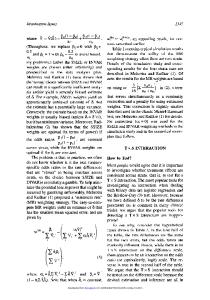Multiple Co-primary Endpoints: Medical and Statistical Solutions: A Report from the Multiple Endpoints Expert Team of th
- PDF / 19,634,153 Bytes
- 16 Pages / 612 x 792 pts (letter) Page_size
- 16 Downloads / 275 Views
Walter Offen (Chair)
Eli Lilly and Company Christy Chuang-Stein Pfizer
Alex Dmitrienko Eli L i l y and Company Gary Littmon Wyeth
Jeff Moco Novart is
Laura Meyerson
31
Multiple Co-primary Endpoints: Medical and Statistical Solutions A Report From the Multiple Endpoints Expert Team of the Pharmaceutical Research and Manufacturers of America
Biogen-ldec
Robb Muirhead Pfizer
Paul Stryszak Schering Plough
Alex Boddy Sanofi-Aventis Kun Chen Bayer
Kati Copley-Merrinan Pfizer
Willard Dere Amgen
Sam Givens Hoffman-LaRoche
David Hall Boehringer-lngelheim
David Henry Bristol Myers Squibb
Josepb D. Jackson
There are quite a few disorders for which regulatory agencies have required a treatment to demonstratea statistically significant effect on multiple endpoints, each at the one-sided 2.5% level, before accepting the treatment’s efficacyfor the disorders. Depending on the correlation among the endpoints, this requirement could lead to a substantial reduction in the study’s power to conclude the efficacy of a treatment. To investigate the prevalence of this requirement and propose possible sdutions, a multiple-disciplinary Multiple Endpoints Expert Team sponsored by Pharmaceutical Research and Manufacturers of America was formed in November 2003. The team recognized early that many researchers were not ful-
ly aware of the implications of requiring multiple co-primary endpoints. The team proposes possible solutions fiom both the medical and the statistical perspectives. The optimal solution is to reduce the number of multiple co-primary endpoints. If after carefulconsiderations, multiple co-primary endpoints remain a scientific requirement, the team proposes statistical solutionsand encourages that regulatory agencies be receptive to approaches that adopt modest upward adjustments of the nominal significance levels for testing individual endpoints. Finally, the team hopes that this report will draw more attention to the problem of multiple co-primary endpoints and stimulate further research.
Bristol Myers Squibb
Alok Krishen ClaxoSmithKline
Thomas Liu Amgen
Steve Ryder Pfizer
A. J. fankoh Sanofi-Aventis Julia Wang j&j PRD
Chyon-Hwa Yeh Procter & Gamble
Key Words Bayesian approach; Mixed Bayesian/ frequentist approach; Multiple endpoint expert team: Multiplicity adjustment; Restricted null space; Reverse multiplicity
Correspondence Address Walter W Offen. Global Statistical Sciences.
Eli Lilly and C o m p a n j Lilly Corporate Center. Indianapolis, IN 46285-2233 (e-rnail: offen-walter-w@lilly.
com).
I N T R O D U CTI 0 N Most human diseases are characterized by multiple measures, including signs, symptoms, quantitative measurements, and patient-reported outcomes. Migraine, for example, is characterized by moderate-to-severe headache pain that is frequently accompanied by nausea, photophobia, and phonophobia. Arthritis patients experience not only pain, but also swelling and stiffness in their joints. Alzheimer’s disease is characterized by poor cognition and disorderly behavior or deficits in activi
Data Loading...











